An unreliable electrical system can cost businesses thousands in downtime, repairs, and lost productivity. Faulty wiring, overloaded circuits, or outdated installations aren’t just minor inconveniences—they can lead to serious hazards like electrical fires or equipment failures. In the UK, businesses are legally required to ensure their electrical infrastructure is safe, regularly maintained, and compliant with strict regulations.
A well-planned electrical system isn’t just about safety—it’s about efficiency too. Energy-saving installations, smart automation, and routine maintenance can reduce running costs while keeping operations smooth. Whether setting up a new workspace or upgrading an existing system, businesses must take a strategic approach to electrical planning. This guide covers everything from legal obligations to practical steps for creating a safe, cost-effective setup.
Understanding Legal Obligations
Every business in the UK must comply with strict electrical safety regulations. The Electricity at Work Regulations 1989 outlines the responsibility of employers to maintain safe electrical systems, while the Health and Safety at Work Act 1974 ensures that workplace environments do not pose risks to employees. Failure to comply with these laws can lead to hefty fines, liability claims, or even prosecution.
One critical aspect of compliance is proper electrical documentation. Engineers and electricians rely on standardised symbols for wiring diagrams and circuit plans. Incorrect interpretations can lead to faulty installations or compliance failures. If you’re unfamiliar with these, check out our electrical symbols guide for a detailed breakdown.
For official regulations, refer to the Health and Safety Executive (HSE), which provides guidelines on maintaining electrical safety in commercial environments.
Conducting Regular Electrical Surveys
Routine Electrical Installation Condition Reports (EICRs) are a legal requirement for commercial properties. These inspections assess the safety of electrical installations and identify potential hazards before they become serious risks.
The Institute of Engineering and Technology (IET) Wiring Regulations (BS 7671) recommends that businesses carry out EICRs at least every five years or more frequently for high-risk environments. During an EICR, a qualified electrician will inspect wiring, circuit breakers, earthing systems, and potential faults.
Neglecting these inspections can lead to undetected faults, increasing the risk of power outages, fires, or electrical shocks. You can learn more about these safety standards from the IET official site.
Implementing Preventative Maintenance
Electrical issues often start small—loose connections, worn-out insulation, or minor fluctuations in voltage. Left unaddressed, these can escalate into major breakdowns, causing costly repairs and downtime. Preventative maintenance helps businesses avoid such disruptions by identifying and resolving issues early.
A proactive maintenance plan should include:
- Routine checks of wiring, outlets, and distribution boards to detect overheating or wear.
- Testing residual current devices (RCDs) to ensure they trip correctly and prevent electric shocks.
- Verifying surge protection systems to safeguard sensitive equipment from voltage spikes.
For businesses seeking professional electrical maintenance, explore our commercial electrical services to keep your systems compliant and efficient.
Upgrading to Energy-Efficient Systems
Energy efficiency is no longer optional—it’s a necessity for businesses looking to cut costs and meet sustainability goals. One of the simplest ways to reduce electricity consumption is by upgrading to LED lighting, which uses up to 80% less energy than traditional bulbs.
Other cost-saving upgrades include:
- Smart meters for tracking energy use and identifying waste.
- Occupancy sensors that switch off lights and appliances in unused areas.
- High-efficiency electrical motors to reduce power consumption in industrial setups.
The UK government’s Energy Savings Opportunity Scheme (ESOS) provides businesses with strategies to improve energy efficiency. Investing in these upgrades can lead to significant long-term savings.
Integrating Building Automation Systems
A Building Automation System (BAS) allows businesses to control and optimise their electrical systems efficiently. By automating lighting, heating, and cooling based on occupancy levels, businesses can reduce wasted energy and improve workplace comfort.
Key benefits of a BAS include:
- Automated lighting and HVAC adjustments for energy savings.
- Remote monitoring to detect faults before they cause disruptions.
- Improved security by integrating smart access controls and alarms.
These systems are particularly beneficial for larger commercial properties, where manual energy management is impractical.
Ensuring Intrinsic Safety in Hazardous Areas
Certain industries—such as manufacturing, chemical processing, and fuel storage—require additional intrinsic safety measures to prevent electrical sparks from igniting flammable gases or dust.
In these environments, electrical systems should include:
- Explosion-proof enclosures for wiring and control panels.
- Low-voltage circuits that limit energy to prevent ignition.
- Grounding and bonding to dissipate static electricity.

Training Staff on Electrical Safety
Even with the best electrical system in place, safety depends on those using it. Employees must be trained to recognise hazards, use electrical equipment correctly, and respond to emergencies.
Key training areas include:
- Identifying overloaded circuits and faulty outlets.
- Knowing emergency shut-off procedures.
- Safe handling of electrical tools and machinery.
Regular safety briefings and workshops ensure that staff remain aware of best practices, reducing the risk of accidents.
Engaging Professional Electrical Services
Setting up and maintaining a safe electrical system requires expertise. Attempting DIY electrical work or hiring unqualified contractors can lead to compliance failures, increased risks, and costly mistakes.
Professional electricians provide:
- Certified installations that meet UK regulations.
- Expert fault-finding to prevent electrical failures.
- Ongoing support and maintenance for long-term safety.
For tailored electrical solutions, contact us to speak with qualified professionals about your business needs.
FAQs
How often should EICRs be conducted?
Businesses should have an EICR at least every five years, though high-risk environments may require more frequent checks.
What are the benefits of upgrading to LED lighting?
LED lights last longer, use less electricity, and reduce maintenance costs compared to traditional bulbs.
Why is staff training on electrical safety important?
Proper training prevents accidents, improves emergency response, and ensures employees handle electrical equipment safely.
Conclusion
A safe and efficient electrical system isn’t just about compliance—it’s a smart investment in your business’s longevity. Regular inspections, preventative maintenance, and energy-efficient upgrades reduce risks, cut costs, and improve overall operations.
By working with qualified professionals and adopting best practices, businesses can ensure their electrical infrastructure remains safe, reliable, and cost-effective.
For expert electrical services tailored to your business needs, visit Wave Electrical Solutions today.










